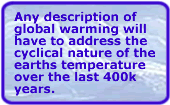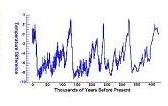What
it Means
During
the period of polar ice cap melting, consider the Atlantic Ocean.
Most of the cold, fresh water created by the melting flows
out
through the North
Atlantic. Very
little comes out to the Pacific just because of how the land is. Remember
the movie Red
October, where submarines use the rush of cold water
deep in the ocean between Iceland and England to travel quickly into
the mid Atlantic Ocean. This
rush of deep cold fresh water causes a current that forces
the surface warmer water to flow north towards Europe and estabilishes
most
of the overall ocean currents. The warm weather in northern Europe
and eastern Canada contributes to and intensifies the melting
of
the
ice cap, which in
turn intensifies the warmer northern weather, thus causing more melting,
more flow of water and warmer weather yet.
 |
|
This
cycle clearly cannot continue forever. At
some point enough of the polar ice cap has melted so that there
is no longer such a
large net flow of cold
water out of the Arctic. At
this point the northern flow of warm water on the surface and the warm
air flowing into Northern Europe will
be reduced. Instead
of melting, the Arctic will again start to build up ice. The
slow 100k glacial period will start and the buildup of ice will continue
over the 100k years
since there is no more north Atlantic current to melt the ice.  The feedback
loop of melting causing warm weather is now replaced with freezing of
the ice cap causing cooler weather. The ice cannot build up forever,
as the earth absorbs
too much energy from the sun to completely freeze up. So at some point,
the build up of ice is enough that it starts to melt even though the
north Atlantic
is not warming it. At that point, the north Atlantic will again start
the warming feedback loop and the cycle of dramatic warming (10k years)
followed by slow
freezeup (100k years) will continue. The feedback
loop of melting causing warm weather is now replaced with freezing of
the ice cap causing cooler weather. The ice cannot build up forever,
as the earth absorbs
too much energy from the sun to completely freeze up. So at some point,
the build up of ice is enough that it starts to melt even though the
north Atlantic
is not warming it. At that point, the north Atlantic will again start
the warming feedback loop and the cycle of dramatic warming (10k years)
followed by slow
freezeup (100k years) will continue.
Remember
too, although the buildup of ice takes a long time, the actual
temperature changes in a particular place caused by the flow of
the ocean
occur on
a much smaller time frame. The temperature
charts show differences ranging from 2
degrees to 10 degrees celsius occuring over a relatively short time
frame (ie. decades). The principle change will come in the flow
of the Atlantic Ocean and the related weather changes caused by
no more gulf stream affecting the weather in Eastern Canada, the
Eastern US and Northern Europe.
Conclusions
The earth has a natural warming
and cooling cycle that lasts just over 100 thousand years. The
cycle goes from virtually no ice in the arctic, to substantial
buildup of ice in the arctic.   The complete melting of the polar
ice cap is what triggers the next round of cooling. The natural
flow of the Atlantic Ocean is what sustains the warming and cooling
cycles. The complete melting of the polar
ice cap is what triggers the next round of cooling. The natural
flow of the Atlantic Ocean is what sustains the warming and cooling
cycles. The
sea level would rise another 6.5 meters if most of the ice
on Greenland melts (as it did in the last and every other interglacial period).
Also remember that the melting of the ice shield over North
American and Europe over the last 10k years has raised sea
levels by an estimated 120 meters.
How long before all of the Greenland ice melts and sea levels rise another 6 meters? 500 years? 200 years?
What will happen after it melts? Will the Atlantic
ocean current reverse causing considerably cooler temperatures
for a long time in places like Northern Europe, Toronto and
New York?
There exists a clear record of what has happened in
the past. Will it happen again? We need to know. |
Is
Canada Ready...
|

